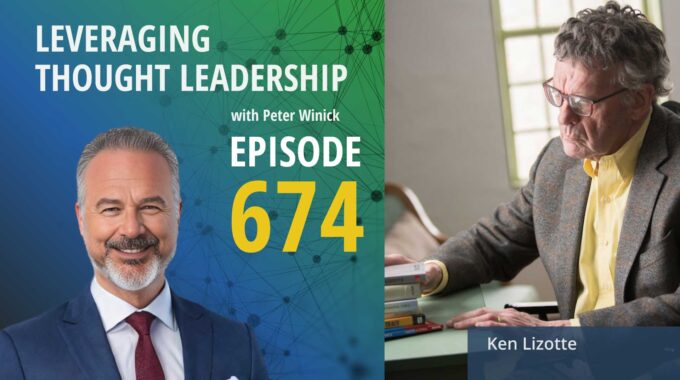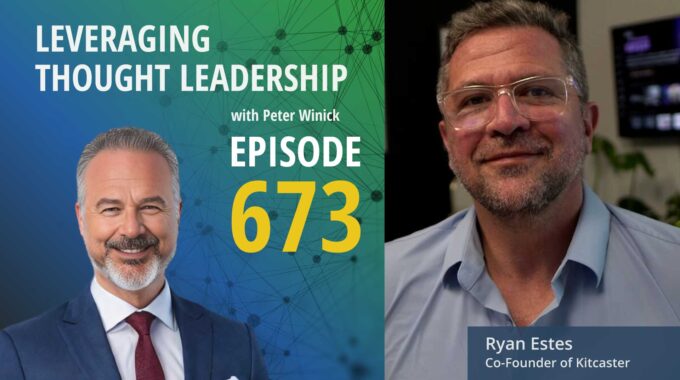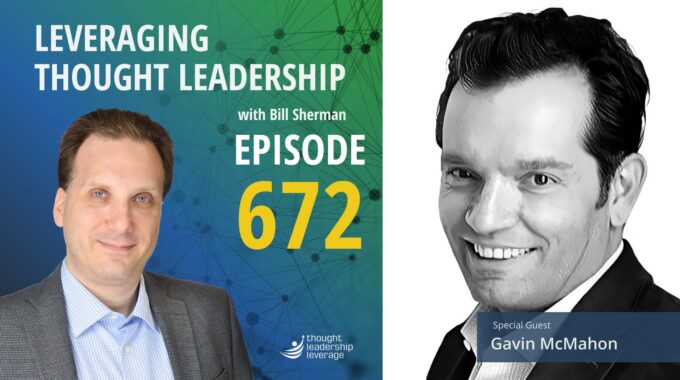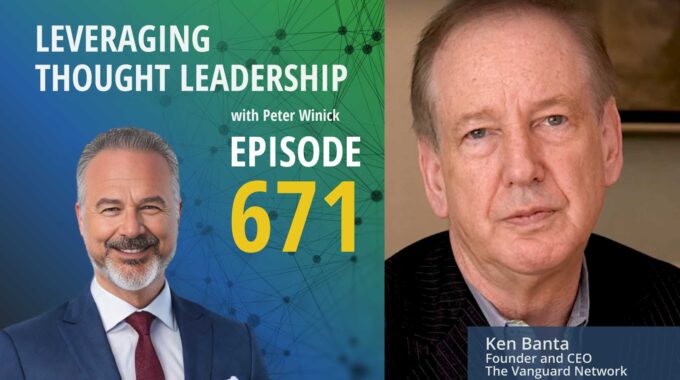Why Great Thought Leaders Don’t Play the Publisher’s Game Peter talks with publishing expert Ken…
Fundraising Beyond Size: Secrets for Scaling Nonprofit Impact | James Misner
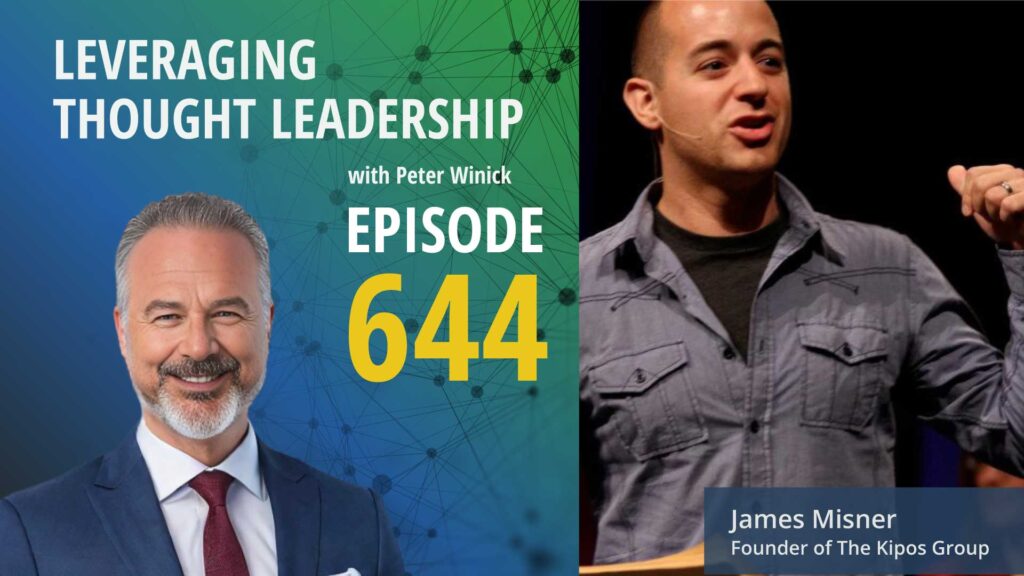
The power of thought leadership in solving nonprofit fundraising challenges.
Nonprofit organizations often struggle to scale due to weak fundraising and limited business acumen, despite having powerful missions. Thought leadership plays a crucial role in equipping nonprofit leaders with essential business skills, targeted strategies, and confidence to secure funding and amplify impact. Overcoming perfectionism and strategically sharing valuable insights freely can significantly accelerate growth and visibility in the nonprofit sector.
Have you ever wondered why some nonprofits make a huge impact while others struggle to grow? The difference isn’t always their mission—it’s their ability to fundraise and scale effectively.
James Misner, founder of The Kipos Group, joins us today to reveal why bigger doesn’t always mean better in the nonprofit sector. James spent 25 years witnessing smaller nonprofits achieve incredible results—only to remain largely invisible due to weak fundraising skills.
We dive into the critical business skills most nonprofit founders lack, from building fundraising teams to understanding marketing ROI. James explains how he helps these leaders think differently, equipping them with essential tools to fundraise confidently and sustainably.
James also shares powerful insights on thought leadership strategy. Instead of chasing large, vague markets, he advocates for targeting highly specific audiences. He discusses why giving away your best insights freely creates a pipeline of opportunity, helping more people and generating growth simultaneously.
Finally, we explore the challenge of perfectionism in thought leadership content. James encourages leaders to overcome their fear of judgment and embrace sharing imperfect but impactful ideas. If your mission matters, James argues, it’s time to hit “publish.”
Three Key Takeaways
Smaller nonprofits can achieve massive impact if they master fundraising and marketing skills typically seen in larger organizations.
Focusing your thought leadership on a narrowly defined audience can drive stronger engagement and better outcomes than chasing broad markets.
Overcoming perfectionism and generously sharing valuable insights can create trust, generate opportunities, and significantly accelerate your organization’s growth.
If you found value in James Misner’s insights on equipping nonprofits with the tools to scale through thought leadership and targeted fundraising, you won’t want to miss our conversation with Stu Manewith in the episode “Thought Leadership Advocacy for Nonprofits”. Stu dives into how nonprofit leaders can leverage their voices to advocate for their mission, build trust with donors, and create lasting impact. Together, these episodes offer a powerful playbook for nonprofit professionals looking to pair strategic thinking with storytelling to drive real change. Listen to both and discover how to amplify your organization’s influence from the inside out.
Transcript
Peter Winick And welcome, welcome, this is Peter Winick. I’m the founder and CEO at Thought Leadership Leverage. And you’re joining us on the podcast today, which is Leveraging Thought Leadership. My guest today is James Misner. He’s with the Kipos organization and he is a thought leader extraordinaire. So instead of going into sort of a long bio, he’s got an interesting niche and an interesting organization that he runs that’s got a big basis in thought leadership. So I just want to talk to him about his story. So what’s going on today, James? How are you?
James Misner Awesome, thanks for having me on, Peter. This is great to be here with you and what’s going on? I don’t know, a lot’s happening in the world right now.
Peter Winick Yeah, a little bit, a lil’ bit. Give me the story, if you would, of what it is you do, and then the importance and the role of thought leadership to get the word out, to get message out. Yes, sir. That you wanna serve.
James Misner Yeah, so we serve exclusively nonprofits, okay? And we serve small and mid-size nonprofits. I’ve been in the nonprofit space, you know, 25 years. And when I chose to leave my nine to five and start the company, there was an idea that generated it. And that idea was that in the non-profit space, bigger wasn’t always better. It just meant that you were better funded. And over my 25 years have found that there are really innovative small and mid-size organizations that are doing astounding, like world-changing work. And the only reason you and I don’t know about them is because they don’t how to fundraise and they’ve not been able to scale. So we scour the nonprofit space to find those really innovative, successful, high-impact, smaller mid-sized organizations and then teach them how to fund raise so they can create beautiful stuff In this really virulent world you live in.
Peter Winick In the nonprofit world and people sometimes don’t really understand that all a nonprofit is at the end of the day is a tax status, right? That’s all it is right now. Most of us think of a nonprofit and I think rightfully so is their mission driven, they’re, you know, teaching literacy, feeding the poor, doing all these amazing and wonderful things. And there’s so many founders that come up with some amazing, amazing missions and want to really, really do great stuff. And the sort of the parallel that I use in the business world and the world of thought leadership, they might stink at marketing and sales, which in the nonprofit world is fundraising, right? No money. No, you don’t have, you’re not getting the money in the door. You can’t do the thing that you want to be doing. And it’s a, you know, it’s critical piece that you talk about. Yeah. Like the big ARPs of the world and The American Red Cross, they probably don’t, they’ve probably cracked the code on that, right. Let’s crack the code.
James Misner Hospitals have cracked the code, higher ed has cracked the code, but your, your food pantries, your, you know, your health centers, your rural Africa XYZ fill in the blank. They haven’t cracked the coat on it yet. And that’s what we’re here to help them do and help them think different.
Peter Winick So from a thought leadership scam point, if I were to market a new product or service, one of the strong pieces that you think about is how much value I’m giving for the dollar, how much better am I than the competition? Why am I faster, better, cheaper, quicker? That doesn’t totally play in the, in the world of nonprofit, right? So what’s the parallel there? What’s the thought leadership that if I, if, I were the founder of a cool, smallish nonprofit that I need to be thinking about.
James Misner Yeah, so some of the things we put out in the thought leadership space are we really try to identify what their real, felt pain points are and then create content and leadership thinking around that. Now, whether if those should be their pain points or not, Peter, that’s a completely different question because some of these guys don’t have a lot of business acumen and we need to get them there. But if their pain point is, I don’t know how to build a team around this. Okay, well, we created a comprehensive guide on that that we push out through all of our channels on how do you build a comprehensive fundraising and marketing team in the nonprofit space? Some of these guys, if you say, Hey, what’s your ROI against your, your marketing spend right now? RR what they have no idea because they came up on the program side of things. They’ve solved something that humans need, but they’ve not solved for the business. So we kind of. Create content to figure out where their pain points are, whether that’s teaming, whether that is how to get a talk, whether that it is how to ask a major donor for money. And we create content for that. And then when they start talking to us, we ask some questions that then hopefully in their mind create some more pain points to some of the things they need to be doing. And then we help them by solving this. And your business model is really a teach them to fish mom. We don’t do it for them. We teach them how to do it so they don’t need us forever and ever.
Peter Winick Right. So you’ve got to help them develop those capabilities at the team level, at the organizational level, et cetera. So let’s roll that backwards. What are the pain points you’re looking for? Cause I understand, you know, I get the market that you’re, you’re serving. That’s clearly and nicely articulated. At what point do they raise their hand and go, huh, James, we need to talk.
James Misner Yeah, so right now this is actually quite easy for us. So 60% of non-profit cup funding comes from the federal government, okay? So I don’t wanna get political on your podcast, Peter, but a lot of that money has disappeared the past few months. So right now the pain point is we don’t know if we’re gonna make it to the end of 2025. We need help with our rapid response crisis communication plan. So that this is an era for at least our company. Where if you’re not in my industry, if you are not growing right now, there’s something wrong with you because so many people.
Peter Winick Need the help. Let me ask the question differently, right? If you weren’t selling snow shovels during a blizzard, if there wasn’t a blizzard app, how would you sell your snow shovel?
James Misner How would I smell my snow shovels? I would create a really, really refined, small, really specific customer profile, ideal client profile. Yeah. I would make it almost restrictively small, which a lot of people say, why would you do that? Why would you limit yourself? But I would have create thought leadership content just for them, for my persona that I create and target the heck out of it. Okay. Everything What is that?
Peter Winick That answer because oftentimes the answer we get from all sorts of thought leaders is go big or go home. And the reality is there might be 30 people, and I’m just making up a number, 30 people in the world that if you really resonated with them vis-a-vis the thought leadership could be a game changer for your business. So before you worry about 30 million, yeah, that’s right. A hundred million or 3 billion or whatever, 3,000, can you identify 30 people, 50 people, a relatively small number of folks that could have impact, could have leverage, could change the game for you. And I love that way of thinking because it forces you to get really, really specific about why they won’t say yes or why they might not be interested or you’re competing with other initiatives or time or money or whatever. So I like that way thinking.
Peter Winick If you’re enjoying this episode of Leveraging Thought Leadership, please make sure to subscribe. If you’d like to help spread the word about our podcast, please leave a five-star review at ratethispodcast.com. We’re available on Apple Podcasts and on all major listening apps, as well as at thoughtleadershipleverage.com/podcast.
Peter Winick What about sort of community? Cause I would imagine in your world, putting together a community of your clients, founders of nonprofits that are struggling or, or try to figure it out might be a value to.
James Misner Yeah, so we haven’t done that as a company yet, but I was invited into somebody else’s forum two weeks ago. Okay, it was 30 CEOs of relief and development organizations that ran the gamut from under a million to, you know, $2 billion in revenue. And it was for CEOs only. None of the other staff were allowed there. And the organization curated six what they called partners, aka vendors, to show up in different areas. And they surveyed these CEOs in advance, and then they put us into small groups. And our goal was each CEO was allowed to bring one problem to the conference. Right. And then we helped to fix it for them and create them a gain plan in real time. And a lot of other consultants that I work with would say, heck no, that’s free advice. I’m not doing it. Do you know how many calls I have coming out of that two and a half days where I just gain everything away for free? I have more calls than my assistant can handle.
Peter Winick Oh, so stay here a minute because I think that lots of consultancies and organizations that their core asset is their IP have this silly mindset of don’t give anything away. So you were just incredibly generous for two and a half days. You helped a whole bunch of people. You didn’t hide your good stuff, right? You didn’t say, well, let me give them a, I’ll give them an okay idea when they pay me, I give them really good one. Like I assumed you put your best thinking towards it and that leads to more and more and I think that’s really important because there are Situations where you’re going to give certain things away for free. There are situations where you going to charge for it. And there are situations. Where you might charge less than you might like to, or need to, or want to, but I love that mindset of being sort of generous with giving away the thought leadership.
James Misner It’s just who I am as a person. Like if I have a thought and it could help somebody, I actually don’t know how to keep that inside. It could be a strength and a weakness at the same time. The other is, you know, we live in a world full of problems and suffering and brokenness and okay, let’s help each other out. I forget, I think it was a Peter Drucker quote that, you now, all you need to do, what to do to get what you want in the world is help other people get what they want in world. And I tend to try to live by that.
Peter Winick That’s great, that’s great. And then oftentimes people don’t understand when you, when you sort of give away the ideas and the principles, maybe in a talk, you’re going to give away your five best things, some folks have the minds that have said, well, he gave it away. So why, you know, why would they pay me for it? Well, there’s a difference in saying, okay, Hey, I saw you speak James. And that really resonated with me. Let’s talk about bringing you into my company and developing, implementing and executing ideas. Same principles. But then he said, well, why would they pay you for that? They’re going to pay you because most people don’t follow through and do the things and want the expertise and you know, it’s a forcing mechanism.
James Misner Change management is one of the hardest things that any leader does, right? Humans, especially the older we get, we do not like the change. And if you’re leading an institution, great ideas are wonderful. Getting your staff to do the great ideas is a completely different thing. And sometimes you just need a really direct, honest person to get in there and be greased at the elbows. And that’s kind of what I found works, is you give them the great idea and the content in whatever format they like best. Then they’re gonna need your help to implement it. So just be ready, you know, when they call, give it away and then be ready to help them actually do it.
Peter Winick Let’s talk about sort of modality format. So this might get a little wonky, but I think that oftentimes different thought leaders have different ways of getting things out there that they prefer, right? If you’re an academic, you’re going to prefer research. If you are someone that’s more visual, it might be graphics. What are the modalities that you play in and why? That’s a great.
James Misner I think the most visible modality I play in is probably LinkedIn. I post stuff there every single day, and it’s not a cheesy…
Peter Winick You could post a video, you could post an article, is it short form?
James Misner It’s short form, probably 250 to 400 words. Here’s a problem that I see. Here’s how I would solve it. Have you done video? I have done video on LinkedIn, but I have found that since most people are doing it on their phones, even when you add the captions to it, you get much higher response rate when it’s just plain test on LinkedIn.
Peter Winick Depends how you define response rate, but it would be an interesting experiment. Here, we’ll give away some thought leadership leader on dog food here, right? If you were to go through your, your posts and say, here’s the five most popular, the ones that have resonated the most with people and repurpose them same, same exact stuff into video and repost them and see if it gets a similar response, different people, different ways. You know, don’t do it the day after, but my point is, you know, the ideas that resonated in a format. Put that in another format to sort of AB tested a couple of weeks, a couple months apart, and I’d love to hear the outcome of that. No, the FM that did nothing, Peter, stupid idea. But it would be, I think it’s an interesting AB test.
James Misner I’m always a fan for experimentation, so we already know what our best performing posts were in Battle E24. It’s not gonna cost me anything to make three or four videos that are two minutes long, so. Hey, I’ll do it, I will let you know how it goes.
Peter Winick Well, actually, as we start to wrap up, what would you suggest to someone that’s where you are two, three years ago, earlier in the journey, what are the things that you’ve learned that you can maybe shorten the learning cycle for the next little pay it forward? Stop waiting for it to be perfect.
James Misner So ship it. You’re just, you’re just get it out there, get it out there into the world and see how people respond. Somebody somewhere is going to like it. Okay. Learn from that. I think I waited too long, uh, to start writing articles and speaking and all of that. Cause I wanted everything to be 100%. Not 100% today is probably better than a hundred percent. Never. Well, well let me
Peter Winick Let me unpack perfect, because I think there’s two different ways I hear that. One is, okay, here’s the piece I’m going to write about X, and I just keep polishing and polishing and polishing until it’s perfect, which is kind of an excuse to hit send. And then the other is, I got a new idea. I don’t know, maybe it stinks. Maybe people are going to think this is terrible, right? So you’re waiting to make something that is unknown known. Which one are you referring to?
James Misner I’m talking to the former one, where it’s just your excuse, you wanna make it 2% better. When it’s a new idea, I probably would test little chunks of it at a time in smaller audiences and putting it out on the whole internet for the world to see.
Peter Winick Right. I think people over, overthink like, okay, if you put something out and it’s not so great five years later, when somebody meets you at a conference, I have to say, Oh, James, you’re the idiot that wrote that post in January of 2022. Right. That’s not going to happen. Right. It’s going to like, I don’t even remember what I read yesterday half the time. But if it, if it has the makings of them, something that could be bigger, you’re not doing it any service by keeping on your hard drive, right? Ultimately, you got to have the courage to hit send. And the market, your market will tell you that resonates, that doesn’t. And then the trick is what do you learn from that? And what do they do?
James Misner With our clients, we’re often encouraging the CEOs we work with to put out thought leadership into the world about their issue. They’re often so concerned about how people will view them as individuals. There’s a deep pride, right, when we put something out into the word, that it actually underserves their organization. They have these great thoughts, but they never hit post, never hit publish, never accept the podcast spot or the speaking gig because they’re so afraid of how they’ll look. And we work with them a lot on that to get rid of that fear and anxiety around self-perception.
Peter Winick Yeah. I mean, I think the one way to help them get over that potentially is to say, well, if your mission in this world is to shepherd these ideas out, to help the people you’re trying to help get over yourself, right? Like that’s part of your, your purpose for being here is to get that stuff out there and yeah, occasionally you put something out that you’re not thrilled with, not proud of, isn’t your best work, whatever, who cares? We all do it, right. Like not everybody’s every day at work is not your best day at work. Well, this has been a lot of fun, James. I really appreciate it. I wanna thank you for sharing your journey and your story with us.
James Misner Welcome, thanks so much, Peter.
Peter Winick To learn more about Thought Leadership Leverage, please visit our website at ThoughtLeadershipLeverage.com. To reach me directly, feel free to email me at peter at Thought Leadership leverage.com and please subscribe to Leveraging Thought Leadership on iTunes or your favorite podcast app to get your weekly episode automatically.


